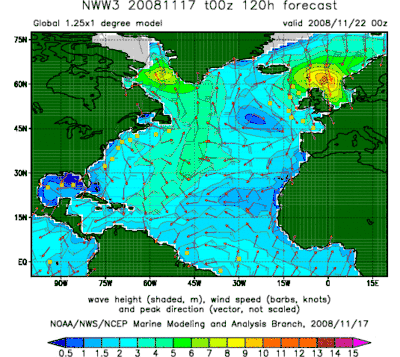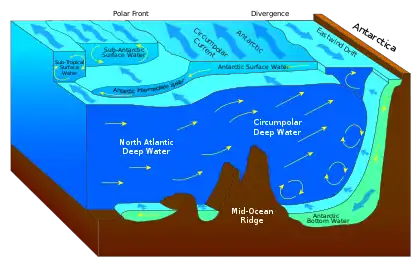| Part of a series on |
| Continuum mechanics |
|---|

In continuum mechanics, wave action refers to a conservable measure of the wave part of a motion.[2] For small-amplitude and slowly varying waves, the wave action density is:[3]
where is the intrinsic wave energy and is the intrinsic frequency of the slowly modulated waves – intrinsic here implying: as observed in a frame of reference moving with the mean velocity of the motion.[4]
The action of a wave was introduced by Sturrock (1962) in the study of the (pseudo) energy and momentum of waves in plasmas. Whitham (1965) derived the conservation of wave action – identified as an adiabatic invariant – from an averaged Lagrangian description of slowly varying nonlinear wave trains in inhomogeneous media:
where is the wave-action density flux and is the divergence of . The description of waves in inhomogeneous and moving media was further elaborated by Bretherton & Garrett (1968) for the case of small-amplitude waves; they also called the quantity wave action (by which name it has been referred to subsequently). For small-amplitude waves the conservation of wave action becomes:[3][4]
- using and
where is the group velocity and the mean velocity of the inhomogeneous moving medium. While the total energy (the sum of the energies of the mean motion and of the wave motion) is conserved for a non-dissipative system, the energy of the wave motion is not conserved, since in general there can be an exchange of energy with the mean motion. However, wave action is a quantity which is conserved for the wave-part of the motion.
The equation for the conservation of wave action is for instance used extensively in wind wave models to forecast sea states as needed by mariners, the offshore industry and for coastal defense. Also in plasma physics and acoustics the concept of wave action is used.
The derivation of an exact wave-action equation for more general wave motion – not limited to slowly modulated waves, small-amplitude waves or (non-dissipative) conservative systems – was provided and analysed by Andrews & McIntyre (1978) using the framework of the generalised Lagrangian mean for the separation of wave and mean motion.[4]
Notes
- ↑ WAVEWATCH III Model, National Weather Service, NOAA, retrieved 2013-11-14
- ↑ Andrews & McIntyre (1978)
- 1 2 Bretherton & Garrett (1968)
- 1 2 3 Craik (1988, pp. 98–110)
References
- Andrews, D.G.; McIntyre, M.E. (1978), "On wave-action and its relatives", Journal of Fluid Mechanics, 89 (4): 647–664, Bibcode:1978JFM....89..647A, doi:10.1017/S0022112078002785
- Bretherton, F.P.; Garrett, C.J.R. (1968), "Wavetrains in inhomogeneous moving media", Proceedings of the Royal Society of London A: Mathematical and Physical Sciences, 302 (1471): 529–554, Bibcode:1968RSPSA.302..529B, doi:10.1098/rspa.1968.0034
- Bühler, O. (2014), Waves and mean flows, Cambridge Monographs on Mechanics (2nd ed.), Cambridge University Press, ISBN 978-1-107-66966-6
- Craik, A.D.D. (1988), Wave interactions and fluid flows, Cambridge University Press, ISBN 9780521368292
- Dewar, R.L. (1970), "Interaction between hydromagnetic waves and a time‐dependent, inhomogeneous medium", Physics of Fluids, 13 (11): 2710–2720, Bibcode:1970PhFl...13.2710D, doi:10.1063/1.1692854, ISSN 0031-9171
- Grimshaw, R. (1984), "Wave action and wave–mean flow interaction, with application to stratified shear flows", Annual Review of Fluid Mechanics, 16: 11–44, Bibcode:1984AnRFM..16...11G, doi:10.1146/annurev.fl.16.010184.000303
- Hayes, W.D. (1970), "Conservation of action and modal wave action", Proceedings of the Royal Society of London A: Mathematical and Physical Sciences, 320 (1541): 187–208, Bibcode:1970RSPSA.320..187H, doi:10.1098/rspa.1970.0205
- Sturrock, P.A. (1962), "Energy and momentum in the theory of waves in plasmas", in Bershader, D. (ed.), Plasma Hydromagnetics. Sixth Lockheed Symposium on Magnetohydrodynamics, Stanford University Press, pp. 47–57, OCLC 593979237
- Whitham, G.B. (1965), "A general approach to linear and non-linear dispersive waves using a Lagrangian", Journal of Fluid Mechanics, 22 (2): 273–283, Bibcode:1965JFM....22..273W, doi:10.1017/S0022112065000745
- Whitham, G.B. (1974), Linear and nonlinear waves, Wiley-Interscience, ISBN 0-471-94090-9

